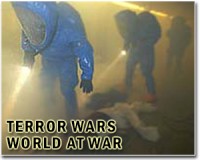 |
Troy NY (SPX) Jul 14, 2010 A major breakthrough in remote wave sensing by a team of Rensselaer Polytechnic Institute researchers opens the way for detecting hidden explosives, chemical, biological agents and illegal drugs from a distance of 20 meters. The new, all-optical system, using terahertz (THz) wave technology, has great potential for homeland security and military uses because it can "see through" clothing and packaging materials and can identify immediately the unique THz "fingerprints" of any hidden materials. Terahertz waves occupy a large segment of the electromagnetic spectrum between the infrared and microwave bands which can provide imaging and sensing technologies not available through conventional technologies such as x-ray and microwave. "The potential of THz wave remote sensing has been recognized for years, but practical application has been blocked by the fact that ambient moisture interferes with wave transmission," says Xi-Cheng Zhang, Ph.D., director of the Center for THz Research at Rensselaer. Dr. Zhang, the J. Erik Jonsson Professor of Science at Rensselaer, is lead author of a paper to be published next week in the journal Nature Photonics. Titled "Broadband terahertz wave remote sensing using coherent manipulation of fluorescence from asymmetrically ionized gases," the paper describes the new system in detail. The "all optical" technique for remote THz sensing uses laser induced fluorescence, essentially focusing two laser beams together into the air to remotely create a plasma that interacts with a generated THz wave. The plasma fluorescence carries information from a target material to a detector where it is instantly compared with material spectrum in the THz "library," making possible immediate identification of a target material. "We have shown that you can focus a 800 nm laser beam and a 400 nm laser beam together into the air to remotely create a plasma interacting with the THz wave, and use the plasma fluorescence to convey the information of the THz wave back to the local detector," explains Dr. Zhang. Repeated terrorist threats and the thwarted Christmas Eve bombing attempt aboard a Northwest airline heightened interest in developing THz remote sensing capabilities, especially from Homeland Security and the Defense Department, which have funded much of the Rensselaer research. Because THz radiation transmits through almost anything that is not metal or liquid, the waves can "see" through most materials that might be used to conceal explosives or other dangerous materials, such as packaging, corrugated cardboard, clothing, shoes, backpacks and book bags. Unlike x-rays, THz radiation poses little or no health threat. However, the technique cannot detect materials that might be concealed in body cavities. "Our technology would not work for owners of an African diamond mine who are interested in the system to stop workers from smuggling out diamonds by swallowing them," Dr. Zhang says. Though most of the research has been conducted in a laboratory setting, the technology is portable and eventually could be used to check out backpacks or luggage abandoned in an airport for explosives, other dangerous materials or for illegal drugs. On battlefields, it could detect where explosives are hidden. The fact that each substance has its own unique THz "fingerprint" will show exactly what compound or compounds are being hidden, a capability that is expected to have multiple important and unexpected uses. In the event of a chemical spill, for instance, remote sensing could identify the composition of the toxic mix. Since sensing is remote, no individuals will be needlessly endangered. "I think I can predict that, within a few years, the THz science and technology will become more available and ready for industrial and defense-related use," predicts Dr. Zhang.
Share This Article With Planet Earth
Related Links Rensselaer Polytechnic Institute The Long War - Doctrine and Application
 al-Qaida mastermind has U.S. in his sights
al-Qaida mastermind has U.S. in his sightsBeirut, Lebanon (UPI) Jul 13, 2010 U.S. counter-terrorism authorities have identified a leading Saudi-born al-Qaida operative as a key figure in a September 2009 plot to bomb New York's subway system, an attack that could have matched the carnage of 9/11. Adnan el Shukrijumah, 34, is a naturalized U.S. citizen but he has a $5 million bounty on his head, a measure of the threat U.S. authorities consider he poses. He is li ... read more |
|
| The content herein, unless otherwise known to be public domain, are Copyright 1995-2010 - SpaceDaily. AFP and UPI Wire Stories are copyright Agence France-Presse and United Press International. ESA Portal Reports are copyright European Space Agency. All NASA sourced material is public domain. Additional copyrights may apply in whole or part to other bona fide parties. Advertising does not imply endorsement,agreement or approval of any opinions, statements or information provided by SpaceDaily on any Web page published or hosted by SpaceDaily. Privacy Statement |